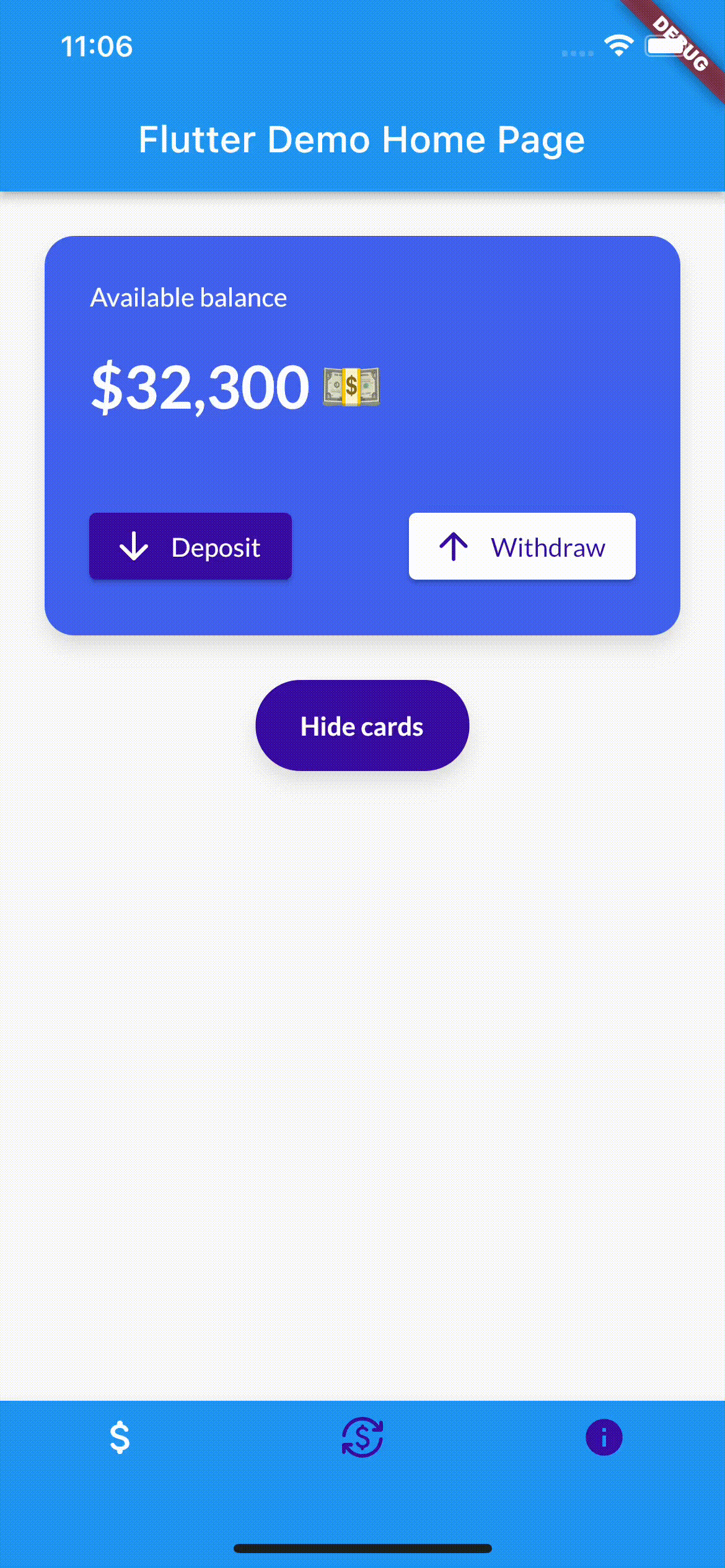Flutter可扩展页面视图插件expandable_page_view的使用
Flutter可扩展页面视图插件expandable_page_view的使用
expandable_page_view是一个能够根据当前显示页面调整高度的PageView小部件。它接受与经典PageView相同的参数。
示例效果
| Horizontal | Vertical |
|---|---|
 |
 |
开始使用
在Flutter项目的pubspec.yaml文件中添加以下依赖项:
dependencies:
...
expandable_page_view: ^1.0.17
然后导入包:
import 'package:expandable_page_view/expandable_page_view.dart';
使用示例
固定Expandable Page View
要创建一个固定页面视图,只需将一组小部件传递给children参数:
ExpandablePageView(
children: [
ExamplePage(Colors.blue, "1", 100),
ExamplePage(Colors.green, "2", 200),
ExamplePage(Colors.red, "3", 300),
],
),
其中ExamplePage可以自定义为如下:
class ExamplePage extends StatelessWidget {
final Color color;
final String text;
final double height;
ExamplePage(this.color, this.text, this.height);
@override
Widget build(BuildContext context) {
return Container(
color: color,
height: height,
child: Center(
child: Text(text, style: TextStyle(fontSize: 24, color: Colors.white)),
),
);
}
}
动态构建的Expandable Page View
如果您有多个页面需要显示,并且希望在滚动时动态构建它们,请使用.builder构造函数并传递itemCount和itemBuilder参数:
ExpandablePageView.builder(
itemCount: 3,
itemBuilder: (context, index) {
return ExamplePage(Colors.blue, index.toString(), (index + 1) * 100.0);
},
),
完整的示例demo
下面提供了一个完整的示例代码,演示了如何使用expandable_page_view插件创建一个简单的应用程序,该应用程序包含三个页面,每个页面有不同的颜色和高度,并且可以通过底部导航栏进行切换。
import 'package:flutter/material.dart';
import 'package:expandable_page_view/expandable_page_view.dart';
void main() {
runApp(MyApp());
}
class MyApp extends StatelessWidget {
@override
Widget build(BuildContext context) {
return MaterialApp(
title: 'Expandable Page View Demo',
theme: ThemeData(
primarySwatch: Colors.blue,
visualDensity: VisualDensity.adaptivePlatformDensity,
),
home: MyHomePage(title: 'Expandable Page View Demo'),
);
}
}
class MyHomePage extends StatefulWidget {
MyHomePage({Key? key, required this.title}) : super(key: key);
final String title;
@override
_MyHomePageState createState() => _MyHomePageState();
}
class _MyHomePageState extends State<MyHomePage> {
int _currentIndex = 0;
@override
Widget build(BuildContext context) {
return Scaffold(
appBar: AppBar(
title: Text(widget.title),
),
body: IndexedStack(
index: _currentIndex,
children: [
BalancePage(),
VerticalBalancePage(),
BasicExamplesPage(),
],
),
bottomNavigationBar: BottomNavigationBar(
backgroundColor: Colors.blue,
currentIndex: _currentIndex,
unselectedItemColor: Color(0xff3a0ca3),
selectedItemColor: Colors.white,
items: [
BottomNavigationBarItem(
icon: Icon(Icons.attach_money_rounded),
label: '',
),
BottomNavigationBarItem(
icon: Icon(Icons.currency_exchange_rounded),
label: '',
),
BottomNavigationBarItem(
icon: Icon(Icons.info),
label: '',
),
],
onTap: (index) => setState(() => _currentIndex = index),
),
);
}
}
// 自定义页面组件
class BalancePage extends StatelessWidget {
@override
Widget build(BuildContext context) {
return ExpandablePageView(
children: [
ExamplePage(Colors.blue, "1", 100),
ExamplePage(Colors.green, "2", 200),
ExamplePage(Colors.red, "3", 300),
],
);
}
}
class VerticalBalancePage extends StatelessWidget {
@override
Widget build(BuildContext context) {
return ExpandablePageView.builder(
scrollDirection: Axis.vertical,
itemCount: 3,
itemBuilder: (context, index) {
return ExamplePage(Colors.blue, index.toString(), (index + 1) * 100.0);
},
);
}
}
class BasicExamplesPage extends StatelessWidget {
@override
Widget build(BuildContext context) {
return Center(
child: Text('Basic Examples Page', style: TextStyle(fontSize: 24)),
);
}
}
class ExamplePage extends StatelessWidget {
final Color color;
final String text;
final double height;
ExamplePage(this.color, this.text, this.height);
@override
Widget build(BuildContext context) {
return Container(
color: color,
height: height,
child: Center(
child: Text(text, style: TextStyle(fontSize: 24, color: Colors.white)),
),
);
}
}
这个例子展示了如何使用expandable_page_view来创建一个具有不同布局和内容的页面视图,并通过底部导航栏在这些页面之间切换。您还可以根据需要调整和扩展此代码以适应您的应用需求。
更多关于Flutter可扩展页面视图插件expandable_page_view的使用的实战系列教程也可以访问 https://www.itying.com/category-92-b0.html
更多关于Flutter可扩展页面视图插件expandable_page_view的使用的实战系列教程也可以访问 https://www.itying.com/category-92-b0.html
当然,下面是一个关于如何在Flutter项目中使用expandable_page_view插件的示例代码。expandable_page_view插件允许你创建一个可扩展的页面视图,类似于某些应用中的可折叠面板。
首先,你需要在你的pubspec.yaml文件中添加该插件的依赖项:
dependencies:
flutter:
sdk: flutter
expandable_page_view: ^最新版本号 # 请替换为实际发布的最新版本号
然后运行flutter pub get来获取依赖项。
接下来,我们编写一个示例页面来展示如何使用expandable_page_view。
import 'package:flutter/material.dart';
import 'package:expandable_page_view/expandable_page_view.dart';
void main() {
runApp(MyApp());
}
class MyApp extends StatelessWidget {
@override
Widget build(BuildContext context) {
return MaterialApp(
title: 'Expandable Page View Demo',
theme: ThemeData(
primarySwatch: Colors.blue,
),
home: ExpandablePageViewDemo(),
);
}
}
class ExpandablePageViewDemo extends StatefulWidget {
@override
_ExpandablePageViewDemoState createState() => _ExpandablePageViewDemoState();
}
class _ExpandablePageViewDemoState extends State<ExpandablePageViewDemo> {
final List<String> titles = ['Page 1', 'Page 2', 'Page 3'];
final List<Widget> pages = [
Center(child: Text('This is Page 1')),
Center(child: Text('This is Page 2')),
Center(child: Text('This is Page 3')),
];
@override
Widget build(BuildContext context) {
return Scaffold(
appBar: AppBar(
title: Text('Expandable Page View Demo'),
),
body: Padding(
padding: const EdgeInsets.all(16.0),
child: ExpandablePageView.builder(
itemCount: titles.length,
itemBuilder: (context, index) {
return ExpandablePage(
header: Container(
decoration: BoxDecoration(
color: Colors.grey[200],
borderRadius: BorderRadius.circular(8.0),
),
padding: const EdgeInsets.all(16.0),
child: Text(titles[index], style: TextStyle(fontSize: 20)),
),
content: pages[index],
expanded: index == 1, // 默认展开第二个页面
onToggle: (expanded) {
// 可以在这里处理展开或折叠的回调
print('Page ${index + 1} is now ${expanded ? 'expanded' : 'collapsed'}');
},
);
},
),
),
);
}
}
在这个示例中,我们创建了一个ExpandablePageView.builder,它使用builder函数来构建每个页面。每个页面都是一个ExpandablePage,它包含一个头部(header)和一个内容(content)。我们还设置了expanded属性来指定哪些页面默认是展开的,并通过onToggle回调来处理展开或折叠事件。
请确保你安装了最新版本的expandable_page_view插件,并检查其文档以获取最新的API和使用方法,因为插件的API可能会随着版本更新而发生变化。








